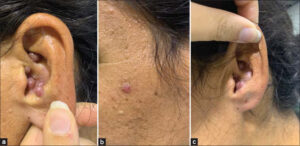Angiolymphoid hyperplasia with eosinophilia: A puzzling new observation
Sabrina Oujdi , Meryem Soughi, Siham Boularbah, Hanane Baybay, Sara Elloudi, Zakia Douhi, Fatima Zahra Mernissi
, Meryem Soughi, Siham Boularbah, Hanane Baybay, Sara Elloudi, Zakia Douhi, Fatima Zahra Mernissi
Department of Dermatology, University Hospital Hassan II, Morocco
Citation tools:
Copyright information
© Our Dermatology Online 2023. No commercial re-use. See rights and permissions. Published by Our Dermatology Online.
Sir,
Angiolymphoid hyperplasia with eosinophilia is a rare pathology characterized by a benign vascular proliferation associated with a mainly eosinophilic inflammatory infiltrate, it mainly affects young women and presents clinically in the form of papules or nodules which may be single or multiple, erythematous or purplish, asymptomatic or itchy in the cervico-facial region, the major problem of this condition is bleeding and aesthetic damage since it’s predominates in the cervico-cephalic region.The diagnosis is based on the anatomopathological study and the therapeutic modalities are varied represented mainly by surgery in paucilesional cases [1].
38-year-old patient, without notable pathological background consults for pruritic lesions in the left ear evolving for 3 years treated as inflammatory acne with cyclin and stéroids without improvement.The clinical examination found multiple well-defined papules and nodules of variable size erythematous with eroded surface for some sitting at the left intra and retro auricular level (Figs. 1a and 1b). A cutaneous biopsy showed a proliferation of vessels of variable size lined with endothelial cells close together and epithelioid in appearance associated with an inflammatory infiltrate made up of lymphocytes and eosinophils. The diagnosis of Angiolymphoid hyperplasia with eosinophilia was retained. a complete blood count was requested showing no hyper eosinophilia. The patient was placed on oral and topic corticosteroid with a good improvement (Fig. 1c).
Angiolymphoid hyperplasia with eosinophilia (ALHE), is a rare entity misunderstood by some dermatologist, initially described in 1969 by Wells and Whimster, it is a benign acquired vascular tumor [1], it is more common in middle-aged Caucasian women with an expression that is most often cutaneous, rarely visceral (salivary glands, lacrimal glands, heart, lungs) or hematological with hypereosinophilia [2–4].
The histological study finds a circumscribed lesion made up of clusters of small capillaries around a medium-sized vessel and located in the dermis, the hypodermis or sometimes the deep soft tissues [2]. These vessels are surrounded by an inflammatory infiltrate composed essentially of eosinophils, and their endothelium is made up of cells with an epithelium or sometimes as a tombstone.
the differential diagnosis are multiple, in particular Kimura’s disease, on the histological level, these conditions include on the one hand an infiltrate composed mainly of eosinophils and lymphocytes, with constant presence of lymphoid follicles in Kimura’s disease, and on the other hand vascular hyperplasia, particularly clear in ALHE where we found voluminous endothelial cells bulging in the lumen, botriomycomas, lymphomatous pathology and metastases of solid cancers are other differential diagnosis, our observation was particular because of the erroneous initial diagnosis relating to inflammatory acne in front of the presence of erythematous papule in the ear and neck.
Several therapeutic approaches have been tried in the treatment of ALHE: electro-dissection, cryotherapy, glucocorticoids by systemic route or intralesional, Argon laser or dye phototherapy pulsed, laser CO2, interferon-alpha, retinoids, radiotherapy, chemotherapy but the treatment of choice remains surgery in the paucilesionnal form [3], the natural course of the disease is characterized by frequent recurrences after well-considered treatment, a new therapeutic based on propranolol at the dose of 40 mg per day during 3 months has recently been described with good efficacy without significant adverse effects [4].
Angiolymphoid hyperplasia with eosinophilia is a rare and benign disease. It is commonly confused with multiples pathologies. The diagnosis can be made with careful history, clinical examination and histology. Several treatments have shown efficacy such as ablative laser, surgery and glucocorticoids, propranolol per os may be a better treatment option than corticosteroid therapy in ALHE by reducing the risk of side effects while still being effective.
Consent
The examination of the patient was conducted according to the principles of the Declaration of Helsinki.
The authors certify that they have obtained all appropriate patient consent forms, in which the patients gave their consent for images and other clinical information to be included in the journal. The patients understand that their names and initials will not be published and due effort will be made to conceal their identity, but that anonymity cannot be guaranteed.
REFERENCES
1. Tauziède-Espariat A, Raffoul J, Sun SR, Lassabe C, Monnin C. [A cutaneous case of angiolymphoid hyperplasia with eosinophilia:Presentation of a rare entity]. Ann Pathol. 2018;38:386-90.
2. Hernandez IDR, Martins CBV, Pantaleão L, Issa MCA. Clinical and histological fi ndings of a typical case of angiolymphoid hyperplasia without eosinophilia:a rare and diffi cult-to-treat disease. Our Dermatol Online. 2019;10:275-7.
3. Ayachi K, Daoud R, Ben Youssef A, Ksibi K, Hannachi W, Dougaz A. Angiolymphoid hyperplasia with eosinophilia]. Rev Stomatol Chir Maxillofac Chir Orale. 2013;114:331-3.
4. Emna B, Mohamed BR, Ben Youness K, Boudawara O, Hamida T. Successful treatment of angiolymphoid hyperplasia with eosinophilia with oral propranolol in two cases. Dermatol Ther. 2021;34:e14994.
Notes
Request permissions
If you wish to reuse any or all of this article please use the e-mail (brzezoo77@yahoo.com) to contact with publisher.
| Related Articles | Search Authors in |
|
 http://orcid.org/0009-0002-5084-9152 http://orcid.org/0009-0002-5084-9152 http://orcid.org/0000-0002-3975-8316 http://orcid.org/0000-0002-3975-8316 http://orcid.org/0000-0003-3455-3810 http://orcid.org/0000-0003-3455-3810 http://orcid.org/0000-0002-5942-441X http://orcid.org/0000-0002-5942-441X |





Comments are closed.